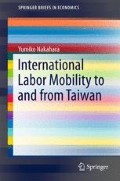Abstract
In 1989, the Taiwanese government legalized employing foreign labor because of a serious labor shortage. However, Taiwan continues to suffer from a labor shortage, which is greater in highly skilled than in unskilled labor. The unemployment rate for unskilled labor is relatively low, whereas that of university graduates has exceeded the average since 2005. One reason for the labor shortage is a low labor participation rate, which is caused by late participation in and early retirement from the labor market. The unskilled labor shortage, which is now considered to be filled by foreign labor to a certain extent, is caused in part by the popularization of higher education. In terms of the shortage in highly educated workers, three types of gaps have triggered this shortage. The demand for caregivers is also increasing because of the aging society, the rising labor participation rate among female workers, and maintenance of the traditional concept of caring for the aged as well as changes in family values.
Access this chapter
Tax calculation will be finalised at checkout
Purchases are for personal use only
Notes
- 1.
1 TWD (Taiwan dollar) = 0.033 USD (US dollar, as of July 12, 2017).
- 2.
Executive Yuan is the executive branch of the central government of Taiwan.
- 3.
Though the legal retirement age was raised from 60 to 65 in 2008, teachers and public servants tend to retire earlier than the usual retirement age (Global Views, October 2015, p. 190).
- 4.
In December 2016, the Ministry of National Defense announced that the military conscription would cease, setting 2017 as the last year (Focus Taiwan News Channel, December 12 2016); hence, the conscription will be eliminated from the reason in the near future.
- 5.
National Statistics, Republic of China (Taiwan), http://www.stat.gov.tw/ct.asp?xItem=37200&ctNode=517&mp=4; http://www.stat.gov.tw/ct.asp?xItem=37135&ctNode=517&mp=4 Accessed May 15, 2017.
- 6.
National Statistics, Republic of China (Taiwan), http://www.stat.gov.tw/ct.asp?xItem=37200&ctNode=517&mp=4; http://www.stat.gov.tw/ct.asp?xItem=37135&ctNode=517&mp=4 Accessed May 15, 2017.
- 7.
Interview with the Director of the Department of Manpower Planning of the Council for Economic Planning and Development on March 18, 2008.
- 8.
Ministry of Education, http://depart.moe.edu.tw/ED4500/cp.aspx?n=002F646AFF7F5492&s=1EA96E4785E6838F# Accessed May 30, 2017.
- 9.
Interview with the Director of the Department of Manpower Planning of the Council for Economic Planning and Development on March 18, 2008.
- 10.
Interview with the Vice Minister of Ministry of Economic Affairs on March 17, 2008.
- 11.
Industrial Technology Research Institute (ITRI) was established by the government for developing technologies useful to the industrial sector.
- 12.
Interview with the Vice Minister of Ministry of Economic Affairs on March 17, 2008.
- 13.
Interview with the Vice President of Company A, Taiwanese PC manufacturer, on August 28, 2007; interview with the Manager of the Department of Human Resources of Company B, Taiwanese PC manufacturer, on August 25, 2009.
- 14.
Interview with the Vice President of Company A, a Taiwanese PC manufacturer, on August 28, 2007.
- 15.
Department of Statistics, Ministry of the Interior, http://sowf.moi.gov.tw/stat/month/list.htm Accessed May 15, 2017.
- 16.
National Statistics, Republic of China (Taiwan), http://www.stat.gov.tw/ct.asp?xItem=37135&ctNode=517&mp=4 Accessed May 15, 2017.
References
Council for Labor affairs, Executive Yuan (2000) Waiji bangyong ji waiji jyanhugweng dui guonei jyouye zh ingsyang (The effect of foreign domestic workers and foreign caregivers to the job opportunity of Taiwanese). Taipei (in Chinese)
Department of Manpower Planning, Council for Economic Planning and Development, Executive Yuan (1989) Donqian laoli duancyue siansiang zh sinchen yu duice (The formation and the countermeasures of the current labor shortage phenomenon). Ind Free China 71(5):17–25 (in Chinese)
Department of Manpower Planning, Council for Economic Planning and Development, Executive Yuan (2005) Sinsheji dierci renli fazhan jihwa minguo 94 zh 97 nyan (The 2nd human resource development plan in the new century 2005—2007). Taipei (in Chinese)
Huang TC (1997) Employee training and management development in Taiwan. Ind Free China 87(6):107–123
Juan PL, Keng SS, Chen PS (2006) Cweng lyang rencai jiaoliou guandian tantao uoguo keji renli ziyuan peiyu wenti (Perspective on training and educating the human resources of science and technology in Taiwan from the exchange of cross-straits). Manpow J Natl Huwei Inst Technol 25(1):43–53 (in Chinese)
Lee JS (1995) Taiwan dicyu laodong sichang syaoneng de shzheng ianjyou (The empirical study about the labor market of Taiwan). In: Liu KC (ed) Taiwan renli zyuan lwenwen ji (Papers about human resources in Taiwan). Lyanjying, Taipei, pp 513–572 (in Chinese)
Lin KS (2010) Taiwan ni okeru koreika (Aging in Taiwan). In: Miura N (ed) Taiwan no toshi koreika to shakai ishiki (The aging of the metropolitan and social awareness in Taiwan). Keisuisha, Hiroshima, pp 15–31 (in Japanese)
Ministry of Education (2016) Jiaoyu twengji zhbyao zh guoji bijiao (International comparison of education statistical indicators 2016). Taipei (in Chinese)
Miyamoto Y (2015) Taiwan no kaigo wo ninau tonan ajia karano dekasegi rodosha tachi (Study on foreign home-care givers in Taiwan). Bulletin of Institute for Interdisciplinary Studies of Culture, Doshisha Womenʼs Coll Lib Arts 32:54–70 (in Japanese)
Oxford Economics (2012) Global Talent 2021. Oxford
Saito N (2015) Koreisha koyo repoto (Report on the employment of aged people), vol 11. Taiwan, Daiwa Institute of Research, Tokyo (in Japanese)
Skeldon R (2006) Recent trends in migration in East and Southeast Asia. Asian Pac Migr J 15:277–293
The Japan Institute for Labour Policy and Training (2016) Databook of international labour statistics 2016. Tokyo
Periodicals
Commonwealth: 550, July 25, 2014. 573, May 27, 2015. 578, August 5, 2015. 580, September 2, 2015. 583, October 14, 2015
Focus Taiwan News Channel: December 12, 2016
Global Views: 352, October 2015
Wealth Magazine: 302, May 2007
Author information
Authors and Affiliations
Corresponding author
Rights and permissions
Copyright information
© 2017 The Author(s)
About this chapter
Cite this chapter
Nakahara, Y. (2017). Background of the Foreign Worker Introduction. In: International Labor Mobility to and from Taiwan. SpringerBriefs in Economics. Springer, Singapore. https://doi.org/10.1007/978-981-10-6047-2_3
Download citation
DOI: https://doi.org/10.1007/978-981-10-6047-2_3
Published:
Publisher Name: Springer, Singapore
Print ISBN: 978-981-10-6046-5
Online ISBN: 978-981-10-6047-2
eBook Packages: Economics and FinanceEconomics and Finance (R0)

